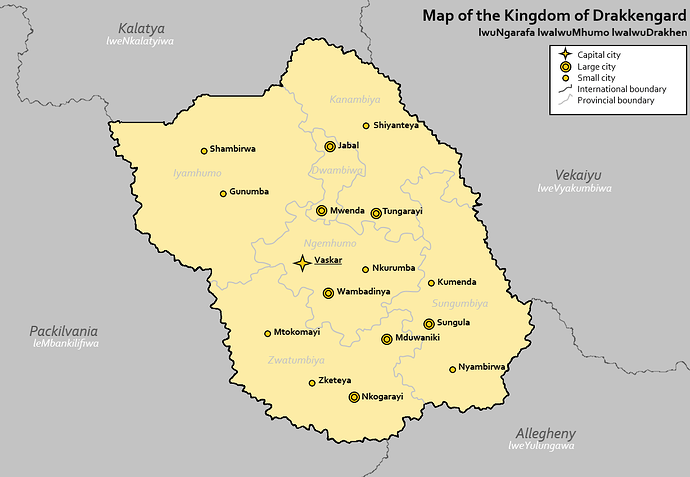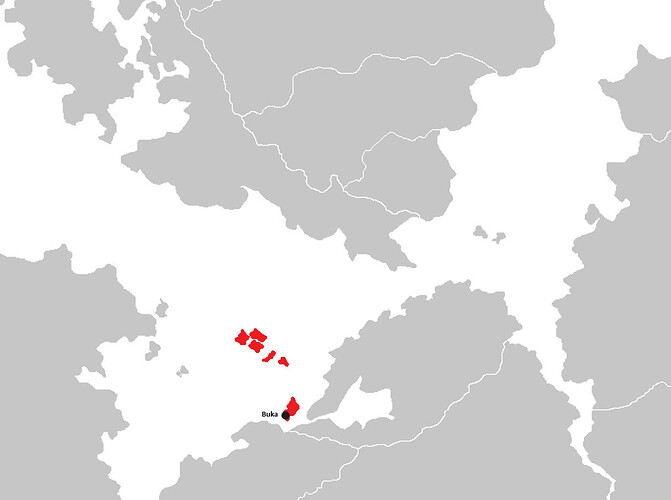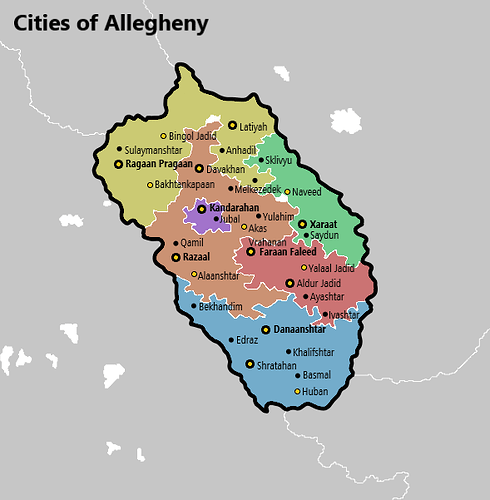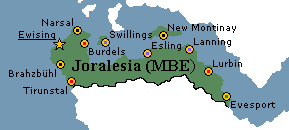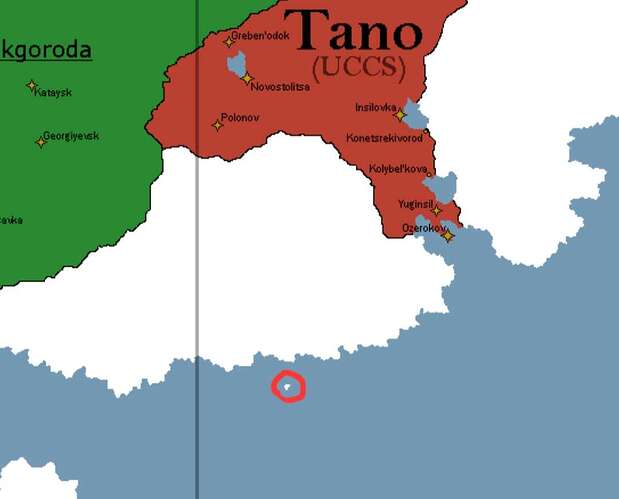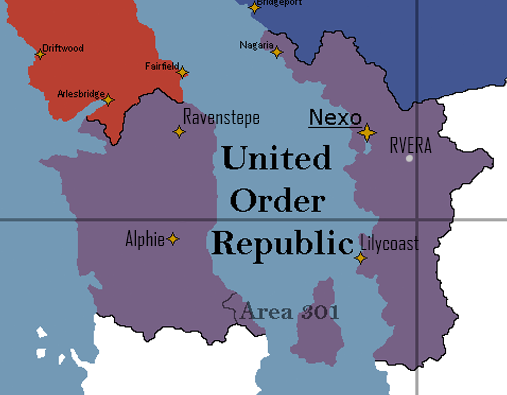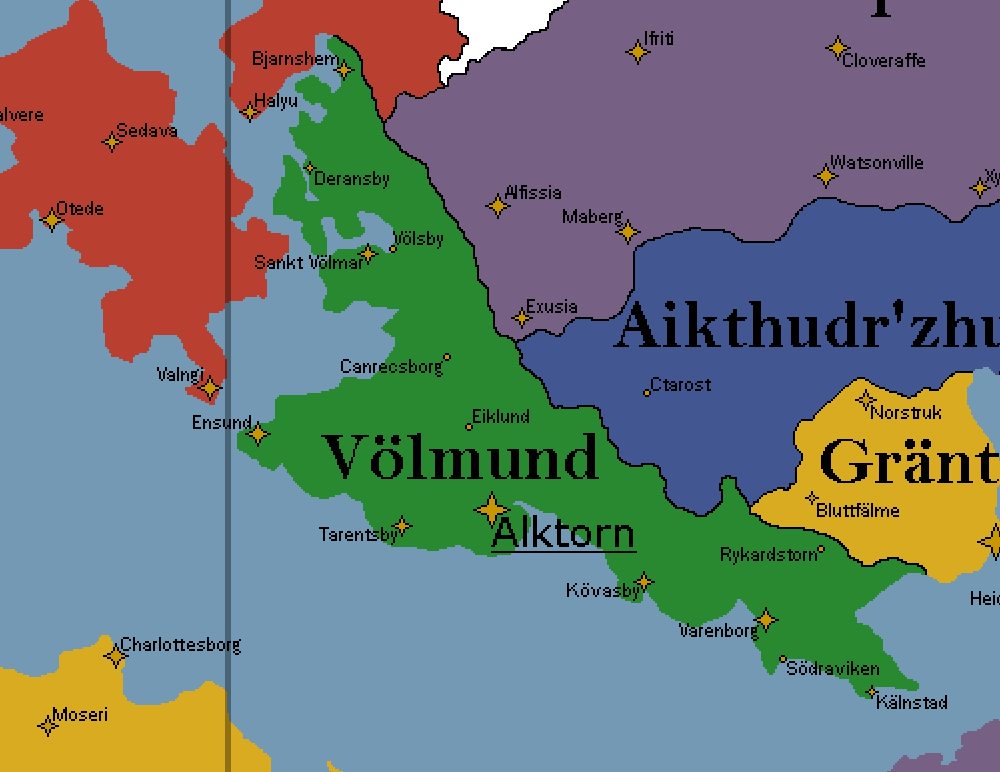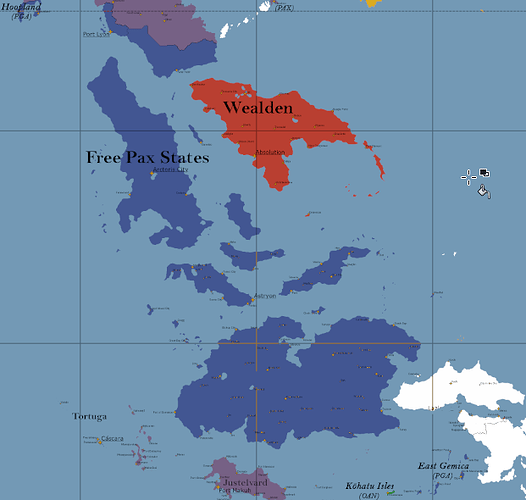Hiya, map deities, I would like to adopt the Federation of Bana from @Acronis
Hemlo map people! Please could you rename Cappedore to Wealden, and perhaps change its map colour to a light-ish blue? Thanks! ![]()
Hello carto friends! There was once a city in eastern Elatana but it seems it got removed from the map at some point. Please restore Navandrís to the map. Thank you!
I have communed with the Sun Pope and been illuminated. Revealed to me was a brand spanking new updated city map for Volscina, the Varentine League, Cavellan, and Seccera.
There are too many changes to list, but by just deleting every city in Volscina/Varentine League/Cavellan/Seccera except for Cadrigrano and then lining up this image below with Cadrigrano everything can be updated without any awkwardness with slight city movements or renames.
Praise the sun!
As Dead has indicated the approval of my expansion here, some map changes.
The below territories are named “Czernomyk” and can be marked as a Cryrian possession. The indicated settlement of Buka can be displayed as a small city on the world map.
Hi, this is my formal post requesting to adopt le Mexregiona. Thanks!
Please rename the Tretridian city of Heahfæsten to Heahceaster.
I have come up with a few new Tretridian cities. The attached image, which also includes the name change for Heahfæsten, has these new cities on there.
Hi Cartos! I would like to change the population of the Stakari Isles.
1,792,138 → 3,458,391
Their GDP would also change.
71,685,520,000 → 138,335,640,000
Hello Cartography.
I am slowly making a return back into Forum RP after the wedding / my long break, and I have begun this with a big desire to burn the excess I own. This will be a slow process as it involves a lot of changes. First of all though, I’m focusing on my southern Concordian possessions.
Please enact the following changes as per the provided image, an overview is below:
- Shrinking Joralesia off mainland Gondwana and moving over most cities except Bhyre (removed). All city sizes to remain the same for now
- Moving Las Joyas to Buzela, village marker, also making New Celidizia marker on Buzela a village, and Port Lokania a town (this name is to replace Tega Tome on the map)
- Changing Bel Amore (Bolize) to Queen Florence Point. Can you remove the name of Bolize and have Buzela cover the sea between them both
(please consider the green map of Joralesia to be the most updated cities map, not the red one. Black square = metro, red square = big city, purple square = small city, green square = town, please) also do you like the Urth vintage map style? ;p
JORALESIA
AREA: 33,247.2km2
POPULATION: 5.79 million (5,791,339; 2023 census)
POP DENSITY: 174.19/km2 (2023)
GDP: 70.09 billion KRB (70,098,367,256; 2023)
GDP per capita: 12,104 KRB (2023)
BUZELA
AREA: 3,081.9km2
POPULATION (TOTAL): 1,261 (2023 census)
POP DENSITY: 0.41/km2 (2023)
GDP: 45.46 million KRB (45,459,050, 2023)
GDP per capita: 36,050 KRB (2023)
HAMISH ISLAND (FORMERLY BOLIZE) AREA: 481.9km2
HAMISH ISLAND (FORMERLY BOLIZE) POPULATION (apart of the total): 84
HAMISH ISLAND POP DENSITY: 0.17/km2
Lots more to come in the following months, but I want to make amendments across the board as I go.
Thanks all.
Hello Cartographers,
I would like to submit a request to change the populations of my countries and territories. I recently noticed that the population densities of some of my countries are quite different than what I had been imagining, and want to change the densities to better reflect what I had in mind. Additionally, I want to reflect normal, IC, annual population growth. The result of this request is that Acronis, Rodoka, Metrati Anar, and Tavaris would increase in population and GDP if approved.
I calculated these new figures in a two step process outlined below. In the included chart, Column F (population) and Column L (total GDP) are the new stats for which I am requesting your approval. I have kept GDP per capita exactly the same. Column G shows the difference in population from the currently approved numbers and what I am requesting.
You can check my work here.
If you would like more information, I go into further detail below:
In this request, I first took the current canon populations of my countries (which were approved in 2022) and then reduced the populations of Elatana, Metradan, Racatrazi, and the Avtovati Isles. By an equivalent total amount, I raised the populations of Acronis, Metrati Anar, Rodoka, and Tavaris, so that the net change in this redistribution was 0. These figures, Column D in the spreadsheet, represent (if approved) an OOC retcon of 2022 population numbers for my countries.
With this redistribution, the population of Racatrazi is more than halved, lowering its density from an absolutely insane 1,023 people per square kilometer to the merely very high 491. Metradan, whose central and northern regions were intended to be much more rural in character due to poor land value, has also been reduced in population. I reduced the population of Elatana so that it is still denser than Tavaris but less so. I have effectively switched the populations of the Avtovati Isles and Metrati Anar, so that Metrati Anar—the older, closer, and more historically strategically important settlement to Tavaris—has the higher population.
In corresponding population increases, both Acronis and Rodoka are raised in population with the intention of making them denser. The Native Rodokan population, during the centuries of Tavari rule, consisted of relatively quickly reproducing humans concentrated in the very small land area over which they retained self-governance. It stands to reason that this arrangement would produce a dense population. In the case of Acronis, the raise in population means that it is no longer true that there are more than double the number of Tavari than Acronians, helping to better reflect a demographic balance capable of generating the kind of underlying tension I had envisioned. The increase in the population of Tavaris represents almost exclusively an increase in Native Rodokan expats living in Tavari Rodoka.
I combined this growth into these calculations by applying a growth rate picked based on IC RP considerations (Column E) to the retconned 2022 populations to generate new population figures for 2023 (Column F). The larger influx of people into Acronis is intentional and meant to reflect an influx of Akronists from around the world choosing to immigrate to the newly independent Akronist homeland after the events of A New Moon Rises. For similar reasons, Tavaris’ population has decreased compared to the retconned 2022 population numbers (Column F compared to Column D).
For your convenience, the totals across all my countries are included on the bottom row. If these stat changes are approved, I will control 76,528 fewer total people on Urth, though the GDP per capita of the whole Tavari Union will increase.
Thank you for your time and consideration!
I just realized I never submitted a request to formally incorporate Serdemia into Aivintis. Apologies for the delay of over a month. Per the discussion between me and the cartography team last year, this incorporation was to take place following an RP which, instead of being an expansion RP, simply demonstrated the value Serdemia has within the lore of Aivintis. This was discussed in a help ticket on the Evolved server which I no longer have access to, but y’all may be able to find it with your permissions in the server. The RP in question was True Justice, a 50-post 6-month 86k-word RP heavily involving Serdemic cities, organizations, and characters in the revolution to overthrow the Aivintian Kritarchy and establish democracy within the nation.
Also I don’t remember if y’all told me to submit it here or in the expansion thread, but I can move this post if you’d prefer.
Previously agreed minor expansion to Vistaraland with cartos. Stats included on wiki, include town marke for Kartesolt only if feasible.
It has occurred to me, perhaps three years too late, that Transnalpia’s demographics do not make sense given its geography. Thus, I would like to request the following stat change for Transnalpia:
Population: 72,000 → 720,000
GDP: 2,016,000,000 → 20,160,000,000
Howdy Cartographers
I Have a request of a name change,
First the Name of my nation which currently reside on the data as United Order Republic to be changed into Orderia as it is more commonly known.
For my Cities
-
Addition Rvera city
-
Name change Theoville into Ravenstepe
-
Name change Greenville into Lilycoast
-
Name change Alpha into Alphie
That’s all, i hope everybody have a good day.
ps. Sorry for the deleted post above
Hello Cartos
I confirm what’s been said in the discord, @Stander0945 is gonna take Phoenixia.
btw Danvreas is in adoption as well
Hello there,
This is technically a map change and not a new nation claim, but so much has changed in terms of lore that I’m sending a whole filled out claim sheet below. I am replacing the Varentine League with a Cryrian Ademarist crusader state, the Monastic Order of the Knights of Völmund.
See claim info below (note - I’ve increased their population significantly, with corresponding GDP per capita changes to make the country much less rich and developed. The gross GDP is identical to what it was on my first claim for what was once the Heisen League.)
Flag:
Nation Name (long): Monastic Order of the Knights of Völmund (Völmarrikes Klosterriddarorden)
Nation Name (short): Völmund / Völmundian Order (Völmarrike / Völmarsk Ordning)
Motto: “Honor-bound and glory-bound.” (“Hedersbunden och ärabunden.”)
National Animal: Elk
National Flower/Plant: Magnolia
National Anthem: “March of the Bladesworn Guard” (“Marsch av det Bladsvurna Gardet”)
Capitol: Alktorn
Largest City: Alktorn
Demonym: Völmundian
Language(s):
- Official: Cryrian
- Other: Talveri, Volscine Norvian, Gränser
Species: 57% Human, 24% Kemonomimi, 11% Elf, 8% Dwarf
Population: ~21.3 million (2023 Census)
Government Type: Monastic Order
Leader(s):
- Ärkemästare Gabriel Hagelin (Archmaster of Völmund, Head of the Conclave)
- Stormästare Herlov af Varenborg (Grandmaster, Chancellor of the First Circle)
- Stormästare Göran Iohansson (Grandmaster, Chancellor of the Second Circle)
- Kolbjörn Ahlström (Knight-Banneret, Flag Admiral of the Order Maritime)
- Jaktmarskalk Dalin Falk (Huntsmarshal, Supreme Commander of the Order Militant)
Legislature: The Bladesworn Conclave (Bladsvuren Konklav). Völmund is a state of knights, operating under a government system that evolved from the original order militant throughout its centuries of history. The Bladesworn Conclave functions as the highest executive power, and on it sit the most experienced and respected knights of the Order. Among other responsibilities, two members of the Conclave are designated as Chancellors, and each one heads a larger legislative body. The smaller upper house of the legislature is the First Circle, while the larger lower house is the Second Circle. Judicial procedures are handled by the Order of Lawspeakers, who run the highest court in Völmund and oversee the operation of regional courts.
Formation: 1110
Total GDP: ~432 billion SHD
GDP Per Capita: ~20,281 SHD
Currency: Accolade (Völmarsk Utmärkelse) (ISO 4217: VMU) (Symbol: Ʉ)
Calling Code: +111
ISO 3166 Code: VM, VMD
Internet TLD: .vm
Historical Summary:
First Founding and the Centennial Crusade:
Initially founded as the Order of the Blades Sworn to Ademar by the knight-banneret Völmar Älgrhammare in 1097, a Cryrian knightly order militant loyal to King Joar III. The Order first saw bloodshed in the Talveri Civil War and the War with the High Places under Queen Lielsta. Under her authority Älgrhammare was granted rights of conquest against the Talveri-Elven held lands to the southeast of Cryria under the condition that the Order convert the region to Ademarism and grant the land to the Kingdom of Cryria when their duties had concluded. The year 1110 saw the Order land near the coast up the river Eikvir, establishing a settlement that would become the modern-day capital of Alktorn. The Alktorn Incursion began a near hundred year-long period of conquest and raiding commonly known as the Centennial Crusade. By 1200 the Order had consolidated the majority of the region, dubbing it Völmarrike (Völmar’s realm) after their founder and patron saint.
Celanoran Subjugation:
Throughout the latter half of the Centennial Crusade the Völmundian Order Maritime had mounted a number of coastal raids against the northern coast of Celanoran Volscina, repeatedly drawing the Empire’s ire and sparking occasional naval skirmishes. The Völmundian-Celanoran conflict culminated in the Grand Northern Campaign in 1204, a Celanoran invasion of Cryria that saw them mobilize the Imperial Navy and the totality of three legions against Völmund and Breze (now Charlottesborg). The war concluded in a Celanoran victory by 1205 after the occupation of Alktorn, the Czernomyk Isles, and the city of Breze. After negotiations with the Kingdom of Cryria, the Celanoran Empire directly annexed Breze, took Czernomyk as a protectorate, and forced the Völmundian Order to swear fealty to the Celanoran crown as an autonomous vassal. Celanoran rule of Völmund saw Norvian grow as a burgeoning second language, as well as the beginning of significant Celanoran settlements along the east coast of the Order’s holdings.
Rise and Fall of the Heisen League:
Seeking freedom from the Celanoran yoke, Völmund joined with Dagomar I of Cadrigrano in the Volscine Revolt of 1267, later joining the Empire of Volscina for protection in 1270 once their war with the Celanoran march of Cavellan had concluded. No longer bound to Cryria or Celanor, the late 13th and early 14th century saw Völmund flourish as an independent state. Notably, the Order’s central bank grew to great significance as a financial body in West Novaris, only rivaled by the Volscine Imperial Mint in Benesuolo. Völmund’s economic hegemony over northern Volscina led to the creation of the Heisen League, a trade league of Volscine city-states centered around Alktorn. The growing might of the League encouraged Völmundian economic and mercantile growth, further diversifying the nation from its militant roots.
In 1512 Völmund, and by extent the Heisen League, initially sided with the Inheritor’s Concordat, the splinter faction backing Princess-Elector Orsa I of Brevento, who arguably held the most legal claim to the throne by right of dynastic succession. Despite this, Völmund’s behavior during the early years of the War of Seven Emperors was much more mercenary than the Princess-Elector had counted on, rarely taking battles or supporting campaigns where it didn’t directly benefit them. Due to this both sides of the alliance began to drift apart, and the Heisen League left the Concordat in 1520, declaring their secession from the Empire of Volscina as a trade alliance helmed by Völmund. The Heisen League monopolized free ports during this time of upheaval, even going as far as to blockade coastal cities opposed to their trading practices, forcing them into the League as junior members. By 1530, the Heisen League had begun to exercise the strength of its combined navy to mount raids on various coastal cities along the Volscine west and south coasts, burning down most of Accanora (modern-day San Lucrezia, renamed four years after the war’s end), and launching a daring raid on Cadrigrano that resulted in Völmundian marines stealing the Golden Throne of Dagomar, one of the three sanctified artifacts of the Volscine Emperor. The War of Seven Emperors ended in 1537, and one year later in 1537 the newly-crowned Empress Lucrezia Sordamor I rallied the still-recovering Empire to war against the Heisen League. While Völmund maintained naval superiority and denied any attempt to land men on the Völmundian heartland, they were unable to defend the disparate cities of the Heisen League, none of whom lasted longer than a month once Volscine troops arrived at their city gates. The Volscine-Völmundian Punitive War ended in a decisive Volscine victory, resulting in every other member of the Heisen League rejoining the Empire in exchange for Volscine recognition of Völmund’s sovereignty.
Free of conflict and the yoke of greater powers for the first time since the Order’s inception, Völmund moved into the early modern period with one hand proffered in peace and the other resting on the hilt of its sword, engaging in peaceful diplomacy while maintaining its state of near-permanent militarization under the semi-stratocratic rule of the Bladesworn Conclave. This saw Völmund mend its estranged relations with Cryria, finding commonality with the Kingdom through their shared institution of faith, the Cryrian Church. On the other hand, Völmund continued its antagonistic maritime behavior, sparking a number of minor trade conflicts with both Volscina and Celanor. After a Celanoran warship based in Viratia sunk a Völmundian merchantman in 1578, the Order Maritime mounted naval raids on multiple coastal towns and cities along Viratia’s northern coast, blockading major ports to dissuade retaliation. While the Celanoran navy was not smaller than that of Völmund, most of it was traditionally in service along the long southern coast of West Novaris, and was unable to quickly relieve any northern elements due to poor relations with Volscina. Nevertheless, the local lords of Viratia were displeased with the idea of sitting passively and giving Völmund free reign, and as such issued a formal declaration of war on behalf of the Celanoran Empire, citing Völmund’s attacks as acts of war themselves. Völmundian leadership called for a crusade against their Lucerist religious enemies, beginning the short-lived Viratine Crusade in the autumn of 1578. By early 1579 Celanoran forces had arrived to relieve the local Viratine hosts, and quickly drove Völmund out of the mainland, but they were unable to achieve naval superiority and were forced to accept a treaty declaring a white peace between the two nations for the next ten years.
The Uradalic Wars:
The mutually friendly policies backing Cryrian-Völmundian cooperation came to a head with the Union of 1830, a political marriage between Queen Ulrika of Cryria and the current Archmaster of Völmund, Knight-Commander Alesantar Uradal. Affectionately called “Ademarsson” by his men, Uradal was a famously zealous military leader who spearheaded Cryrian-Völmundian imperialism in North and West Novaris. Fueled by nationalism, he led Völmund and Cryria on a series of military campaigns across Northern Novaris known as the Boreal Crusade, consolidating the region under Völmundian and Cryrian military rule. With the conclusion of the Boreal Crusade in 1843, Uradal turned his gaze southwards, conspiring with Cryrian nationalists in Charlottesborg to incite a popular revolt against Volscine rule while the Empire was preoccupied with the Volscine-Celanoran War. Spring of 1844 heralded the Charlottesborg Revolts, and the flight of the ruling Reitz family to Cadrigrano. Calling themselves the Free State of Charlottesborg, the revolters pledged their allegiance to Ulrika and Alesantar’s joint goal of pan-Cryrian nationalism, allowing both nations to land troops on the Volscine mainland. Thus began the Northern Containment War, seeing Volscina and their ally Viratia declaring war on Cryria, Völmund, and Charlottesborg, as they did not recognize the latter’s independence as legitimate—they’d overthrown the local monarchy, not the entire structure of the Volscine Empire.
The first two years of the Northern Containment War were bloody and slow-moving, with the fighting in Volscina mostly contained to the Charlottesborg surroundings and Volscine northerly island possessions. More significant inroads were made in northern Viratia, with their capital city of Lustra, still recently recovered from the Volscine-Celanoran War, partially razed by Völmundian troops. Despite its crippled economy, Volscina’s experience with the campaign in Celanora had left it with a military core of battle-hardened veterans led by seasoned commanders, a distinct departure from the ill-equipped and oft unprepared armies of the northern realms so recently subjugated by Cryria and Völmund. Already fighting with the advantage of manpower and direct access to the frontlines, the Volscine war effort was bolstered by the late admission of the Kingdom of Tretrid to the forces of the coalition, and with a definitive naval advantage now secured, the Volscine and Tretridian fleets smashed the wooden wall that had made Völmund and Cryria to invincible to counterattack. Unable to retreat or receive reinforcements, their troops left stranded on the mainland were forced to surrender. When compounded with revolts against Ademarist rule in the north, Cryria and Völmund were forced to accept terms of surrender that saw them relinquish their recent gains and sever ties on an official level, though Uradal remained the Archmaster of Völmund until his death in 1859.
The Great War:
Cryrian dynastic machinations and Imperial internal politics led to the rise of the Tanznozhiv, a Cryrian-Volscine union formed after the elevation of Queen Katharine of Cryria to the position of Empress of Volscina. As the ruler of both nations, she oversaw their entry into the Great War, Cryria forced to join by Volscina’s status as an Asendavian ally and enemy of Tretrid. Völmund, while no longer especially close with either half of the union, chose to side with the Tanznozhiv to avoid conflict with the regional superpower that had suddenly emerged at its doorstep. Völmundian participation in the Great War was limited to volunteer legions primarily composed of knightly initiates of the Monastic Order itself, with Völmund never seeing the need to institute any form of forced draft.
Modern Völmund:
In the modern day Völmund is a largely neutral state, and a member of the Conference for Amity and Cooperation (CAC) alongside Cryria, Antora, and a number of other Novaran nations. Its status as a theocracy has been challenged, but the entrenchment of the Monastic Order as Völmund’s center of government limits how effective reform efforts have been. Significant political change is, without a radical change in government, unlikely to come from anywhere but inside the Order itself. Nevertheless, reformists continue to push for less antiquated policies, citing Völmund’s archaic views on religion and overbearing military presence in government as reasons why the country has remained considerably under-developed in comparison to its neighbors in Cryria and Volscina.
Hello esteemed cartographers! I have a unique request.
As some of you know, I want to continue only on Urth as Free Pax States. For me, this was really solidified after sharing my ideas/what I had done with FPS with the original player behind Free Pacific States during TEP 20, to which he liked what I was doing.
Truthfully I’m a skeptic to be roleplaying right now. I’ve been more worldbuilding and avoiding the problem at hand. The problem is that I’m roleplaying/worldbuilding with a much larger plot than what is allowed and I would like to roleplay at my own pace without having to retcon/cancel an RP every time there might be a sudden map change without an advanced line of communication. Now it did enable me to get some amazing ideas and a real sense of direction on my national identity so not a complaint at all but a subliminal suggestion for the future. I honestly might roleplay more if the air was cleared around my map plot…
Currently, this is how I see the world:
If you think it’s okay then I’ll continue to make it happen in the past. I personally don’t think it will be okay based on experience and the general vibe and that’s why I am in this thread now to figure it all out. ![]()
So let’s clear the air, shall we? A compromise is in order but with a twist. I’m fine with a land reduction but really I would like a reimagination of the entire archipelago and provide me with an entirely new look. After nearly 20 years of the same shape (seriously, look at all the old maps!) something new and blue ![]() might be fun. (I would even be open to anyone who’s not a cartographer sending an idea to you all because why not?)
might be fun. (I would even be open to anyone who’s not a cartographer sending an idea to you all because why not?)
I do have a few must-haves (suddenly this feels like an episode of HGTV’s Love It or List It):
- Keep the northern parts (Hoopland and the land connection to Pax because it’s iconic)
- Tropical.
- Iseul
As far as population? Currently, I stand at 209 million, and you know I’m just going to leave that number in your hands and let you decide if that’s okay or if you have a new number in mind. Surprise me. As it stands most of my population lives in urban centers in the middle of the jungles or on the coast with the rest being really nature preserves or for sourcing plant-based protein.
As far as species it would be like it is now… majority elf and nekomimi population. The minority would be humans, tieflings, and felines. So really no changes really.
Going back to surprise me, yes, I think that’s an amazing idea. When it happens just make it a regular map change update and fill me in on all the details at that point. As far as cities? Just delete them for now because I was working on their new names in Kilumi, Staynish, Kaoghoni, and Wakov as-is. A fresh start might be what I just needed to figure it all out.
Thanks for everything you all do. I appreciate it!



